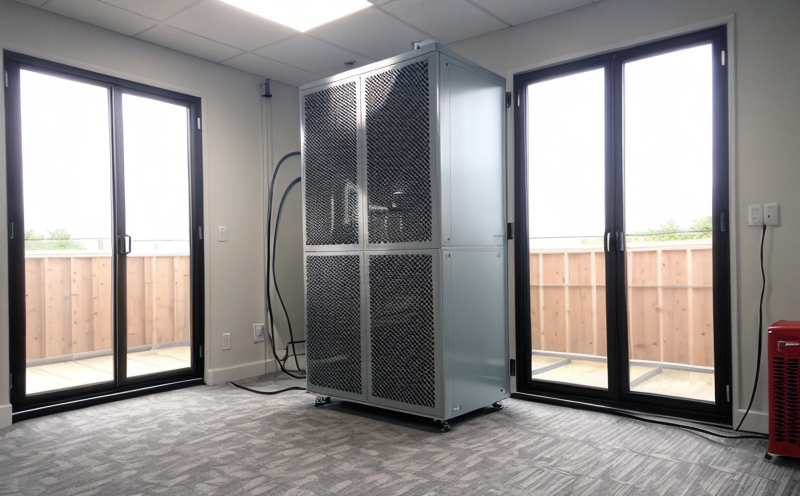BS EN 13779 Air Distribution Performance Test
The BS EN 13779:2008 standard provides a framework for testing and assessing the air distribution performance of HVAC (Heating, Ventilation, and Air Conditioning) systems. This test ensures that the airflow is evenly distributed throughout the space, which is crucial for maintaining optimal comfort levels and energy efficiency.
The primary purpose of this test is to evaluate how well the air supply from ventilation units reaches all parts of a room or building. Proper air distribution is essential in ensuring uniform temperature control across an enclosed area. When airflow is not evenly distributed, it can lead to cold spots or hot zones within the space, resulting in inefficiencies and increased energy costs.
The test involves measuring the velocity and volume of air delivered to different points in a room using specialized equipment like anemometers and flow meters. The results are compared against specified thresholds outlined in EN 13779:2008. Compliance with these standards ensures that HVAC systems operate efficiently, contributing positively to both occupant comfort and energy savings.
During the testing process, various factors influence air distribution performance such as duct design, grilles placement, and fan settings. Understanding these variables helps in optimizing system performance according to specific project requirements. For instance, larger buildings may require more extensive ductwork networks compared to smaller spaces, affecting overall airflow.
It is important to note that improper installation or maintenance can compromise the effectiveness of HVAC systems. Regular testing ensures continuous compliance with industry standards and helps identify potential issues early on before they escalate into significant problems. By adhering strictly to EN 13779 guidelines during initial design phases as well as ongoing maintenance activities, you can ensure long-term reliability and efficiency.
The results of this test play a vital role in determining whether an HVAC system meets the required performance levels specified by the standard. Non-compliance could result in penalties or even legal action depending on local regulations. Therefore, conducting thorough tests at regular intervals is advisable for maintaining high-quality standards across all aspects of HVAC operations.
Why It Matters
The importance of proper airflow distribution cannot be overstated when it comes to maintaining comfortable indoor environments. Poor air distribution can lead to several issues including uneven temperatures, increased energy consumption due to overcompensation by the HVAC system, and discomfort for occupants.
Ensuring that every corner of a building receives adequate airflow not only enhances occupant satisfaction but also contributes significantly towards achieving sustainable practices. By optimizing energy usage through efficient air distribution systems, businesses can reduce their carbon footprint while simultaneously lowering operational costs.
In addition to comfort and sustainability benefits, adhering to rigorous testing protocols like those prescribed in BS EN 13779 helps protect against potential health hazards associated with poor ventilation practices. Properly ventilated spaces are less likely to harbor mold growth or other airborne contaminants that could negatively impact respiratory health.
From an operational perspective, regular testing ensures ongoing compliance with relevant regulations and industry best practices. This proactive approach not only minimizes risks but also fosters trust among stakeholders by demonstrating a commitment to quality control and continuous improvement.
Why Choose This Test
Selecting the BS EN 13779 Air Distribution Performance Test is advantageous for several reasons. Firstly, it provides comprehensive insights into how effectively your HVAC system distributes air throughout the building or facility. This information is invaluable for identifying areas where improvements can be made to enhance both comfort and energy efficiency.
The test offers a standardized methodology that ensures consistent results across different testing environments. This consistency allows for reliable comparisons between current performance levels and desired outcomes, making it easier to track progress over time. Moreover, compliance with this standard helps establish credibility within the industry by demonstrating adherence to recognized international practices.
Another key advantage lies in its ability to detect early signs of potential issues before they become critical problems requiring costly repairs or replacements. Regular testing not only extends the lifespan of HVAC systems but also reduces downtime associated with unexpected failures. By catching these issues promptly, businesses can implement targeted solutions that address specific needs while minimizing disruptions.
Finally, choosing this test aligns your operations with current regulatory requirements and best industry practices. In today’s competitive landscape, demonstrating commitment to quality and sustainability is increasingly important for attracting customers and maintaining a positive reputation. Investing in regular testing shows that you are proactive about ensuring top-notch performance across all aspects of HVAC operation.
Use Cases and Application Examples
The BS EN 13779 Air Distribution Performance Test finds application in various sectors including commercial buildings, industrial facilities, healthcare institutions, and educational campuses. Here are some specific use cases:
- Commercial Buildings: Ensuring that all employees have access to comfortable working conditions is crucial for maintaining productivity and employee satisfaction.
- Industrial Facilities: In manufacturing plants, consistent temperature control in production areas helps maintain product quality while reducing waste.
- Healthcare Institutions: Proper ventilation is critical for preventing the spread of airborne diseases among patients and staff. Regular testing ensures that the system meets strict hygiene standards.
- Educational Campuses: Schools and universities need to provide safe learning environments where students can focus on their studies without being distracted by uncomfortable temperatures or drafts.
In each of these scenarios, ensuring proper air distribution is essential for maintaining comfort levels while also contributing positively towards overall energy efficiency. The test results provide valuable data that can guide necessary adjustments to HVAC systems, leading to improved performance and reduced operational costs.





